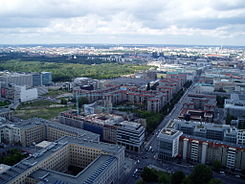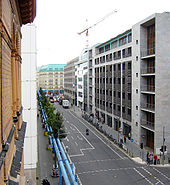Wilhelmstrasse (Berlin-Mitte)
| Wilhelmstrasse | |
|---|---|
| Street in Berlin | |
| View to the north over Wilhelmstrasse, in the front left the Federal Ministry of Finance , in the background the Great Zoo and the Federal Chancellery |
|
| Basic data | |
| place | Berlin |
| District | Mitte , Kreuzberg |
| Hist. Names |
Husarenstrasse , Neue Wilhelmstrasse (1822–1964) , Otto-Grotewohl-Strasse (1964–1993) |
| Connecting roads |
Luisenstrasse (north) , Mehringdamm (south) |
| Cross streets |
(Selection) Dorotheenstrasse , Unter den Linden , Behrenstrasse , Vossstrasse , Leipziger Strasse |
| use | |
| User groups | Pedestrian traffic , bicycle traffic , car traffic , public transport |
| Technical specifications | |
| Street length | approx. 2400 meters |
The Wilhelmstrasse is in the Berlin districts of Mitte ( district center ) and Kreuzberg ( Friedrichshain-Kreuzberg ). It was the seat of important government authorities in Prussia and the German Reich and, in this tradition, is still an important part of political Berlin and the seat of international political institutions. Until 1945, the rhetorical expression Wilhelmstrasse was a metonym for the German Reich government , similar to Downing Street No. 10 stands for the UK government. Despite severe destruction in World War II by the Allied air raids and the Battle of Berlin , numerous historic buildings on Wilhelmstrasse have been preserved; the Berlin monument list names 19 objects worthy of protection. During the GDR era, a large part of the district was built over with prefabricated buildings.
The street, originally laid out in the 1730s as part of a city expansion by King Friedrich Wilhelm I under the name Husarenstraße , was given its current name around 1740 after his death. The area around Wilhelmstrasse was known as the government district , especially during the German Empire and the Weimar Republic .
course
The approximately 2.4 kilometer long road runs in a north-south direction. It begins in the north on the Reichstagufer , crosses the boulevard Unter den Linden on the east side of Pariser Platz and Leipziger Straße and ends today on Halleschen Ufer near Hallescher Tor in Kreuzberg . Its southern end originally ran into the roundabout ( Belle-Alliance-Platz , today: Mehringplatz ), but it was swiveled away from the square around 1970.
Partial closure

Between Behrenstrasse and Unter den Linden, Wilhelmstrasse has been closed to motorized through traffic since 2003 to protect the British embassy there , especially from car bombs .
In 2014, in confidential talks between Berlin's transport and security politicians and the federal ministries, negotiations were held to lift the ban, as a reassessment was expected for British foreign institutions. Another argument in favor of clearing the road section was, among other things, the longer routes for emergency vehicles from the nearby Charité . Before doing this, however, the State Criminal Police Office must evaluate whether the security situation allows this.
However, the decision to release the blocked section is not the responsibility of the district, but rather the federal government. As a compromise proposal, the Berlin CDU MP Oliver Friederici called for two of the four lanes to be released.
history
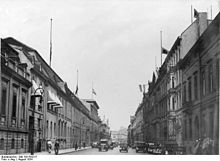

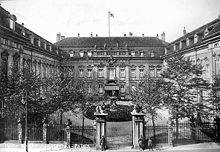
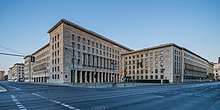

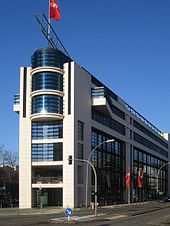

Under the first king "in Prussia " Frederick I , namesake of the Friedrichstrasse , came up in 1706 Friedrichstadt . His son, the "soldier king" Friedrich Wilhelm I , had this enlarged in the 1730s together with the construction of the Berlin customs and excise wall . Husarenstrasse , which was laid out as part of the expansion, was renamed Wilhelmstrasse after Friedrich Wilhelm's death in 1740.
In the northern part of what was then Husarenstrasse, many palaces were built by ministers and personal confidants of the king, such as the Marschall palace built for Samuel von Marschall . Three of these palaces were given a particularly representative design with a courtyard of honor . The Palais Schwerin (named after Kurt Christoph von Schwerin ), later the Palais of the Reich President , the Palais Schulenburg, then the Reich Chancellery and the Palais Vernezobre, later converted into the Prince Albrecht Palais .
From 1737 the Moravian Brethren, who came to Berlin from Bohemia , settled at the southern end of the street .
At the beginning of the 19th century, important ministries of the Kingdom of Prussia took their seat in the street. After the founding of the Reich in 1871, government authorities of the German Reich followed , which, due to the Prussian austerity constraints, were not granted any new buildings, but nevertheless wanted representative buildings. Foreign embassies were building in the immediate vicinity. After the " seizure of power " by the NSDAP in early 1933, the control centers of the NS regime were set up on Wilhelmstrasse.
Many buildings were badly damaged by Allied air raids and the Battle of Berlin during World War II and were cleared after 1945 . In the late 1980s, residential and commercial buildings were built using prefabricated panels between Behrenstrasse and Vossstrasse . They received relatively elaborate facades and were a popular domicile of the GDR - nomenklatura .
After the division of Berlin , Wilhelmstrasse was separated into a northern area that belonged to East Berlin and a southern area that belonged to West Berlin . The border ran at the level of the Niederkirchner / Zimmerstrasse street . In the Kreuzberg section, a number of new residential buildings were built in the 1970s and 1980s, which are part of the existing social housing .
During the Nazi era , the SD main office, the highest command of the Reichsführer's security service, was housed in the Prinz-Albrecht-Palais on Wilhelmstrasse, in the immediate vicinity of the Gestapo headquarters in Prinz-Albrecht-Strasse 8 (today: Niederkirchnerstrasse ) SS (SD). The SD Main Office became part of the Reich Security Main Office (RSHA) in 1939 , which was also located in the Prinz-Albrecht-Palais.
The new building of the Topography of Terror Foundation , which opened in 2010 and is trying to present the street in its historical references to the public under the heading of the Wilhelmstrasse History Mile , is located on the site today . On the initiative of the Berlin House of Representatives , a permanent street exhibition with glass information boards has been showing the locations of earlier institutions since the early 1990s.
Several new buildings are planned on Wilhelmstrasse in 2018, including a. the “Palais an den Ministergärten” along Cora-Berliner-Strasse, for which several temporary snack bars are being demolished.
Development
Before 1945 the following buildings were located on Wilhelmstrasse (house number count at that time):
- Palais Fürstenberg (from 1899 seat of the Society for Geography in Berlin ) (No. 23)
- Reichsschatzamt (from 1919 Reich Ministry of Finance ) (No. 60/61, Wilhelmplatz 1/2 and Kaiserhofstrasse 1–3)
- Reichskolonialamt (No. 62)
- Prussian State Ministry (No. 63, from 1934 seat of the press chief of the Reich government and NSDAP Otto Dietrich )
- Secret civil cabinet (No. 64, from 1919 Prussian State Ministry, 1933–1941 staff of the " Deputy Leader " Rudolf Hess )
- Reich Ministry of Justice (No. 65)
- Prussian Ministry of Culture (No. 68, from 1934: Reich Ministry for Science, Education and National Education )
- British Embassy (No. 70)
- Reich Ministry of Food and Agriculture (No. 72)
- Palace of the President of the Weimar Republic (No. 73, until 1919: Ministry of the Royal House )
- Reich Office of the Interior (No. 74, from 1919: Foreign Office)
- Foreign Office (No. 75/76)
- (Old) Reich Chancellery (No. 77)
- Extension to the (old) Reich Chancellery (No. 78, completed in 1930)
- Palais Borsig ( Voßstraße 1 at the corner of Wilhelmstraße)
- Reich Ministry of Transport (No. 79/80)
- Reich Aviation Ministry (No. 81-85; now: Detlev-Rohwedder-Haus No. 97)
- The traffic science teaching aid company had its seat here (No. 87)
- Prinz-Albrecht-Palais (No. 102), SD-Hauptamt ( security service of the Reichsführer SS ); from 1939 Reich Security Main Office (RSHA), additionally houses 101, 103-105 and from 1937 No. 106 (before that SA-Obergruppenführung Berlin-Brandenburg)
- Ordenspalais ( Wilhelmplatz 8/9), Reich Ministry for Public Enlightenment and Propaganda
The following diplomatic missions had their headquarters in the street, which was renamed Otto-Grotewohl-Straße during the GDR era (in honor of the GDR politician Otto Grotewohl ) since the 1970s:
Number 3a (now: Wilhelmstrasse 66):
- Democratic Republic of Afghanistan
- Greek Republic
- Islamic Republic of Pakistan
- Republic of the Philippines
- Portuguese Republic
- Kingdom of Sweden
- Republic of Zimbabwe
- Syrian Arab Republic
- Republic of Zaire
Number 5 (now: Wilhelmstrasse 65):
- Kingdom of the Netherlands
- Kingdom of Norway
- Republic of Austria
- Republic of Venezuela
The following facilities are currently located in Wilhelmstrasse:
- E-Werk (No. 43)
- Embassy of the Czech Republic (No. 44)
- Federal Ministry of Labor and Social Affairs (No. 49, in the extension of the former Ordenspalais ), main entrance in the Hofmarschallhaus (formerly Wilhelmplatz )
- Federal Ministry of Food and Agriculture (No. 54, formerly: Secret Civil Cabinet , No. 64), one of the few remaining representative old buildings that were not destroyed during the war and that were renovated in accordance with listed buildings when the government moved from Bonn to Berlin
- Matthias Erzberger House of the Bundestag on the corner of Wilhelmstrasse and Unter den Linden
- Robert Koch Forum with Einstein Center Digital Future (No. 67)
- ARD Capital Studio (No. 67a, on the corner of the Reichstagufer )
- British Embassy (No. 70/71) (on the corner of Behrenstrasse )
- Federal Ministry of Finance (No. 97, Detlev-Rohwedder-Haus )
- Exhibition area " Topography of Terror " (it is also adjacent to Wilhelmstrasse and has a side entrance at the former number 98)
- Federal headquarters of the SPD (No. 140, Willy-Brandt-Haus , on the corner of Stresemannstrasse )
Other architectural monuments are also noteworthy, such as the community school built in 1868 (Wilhelmstrasse 116/117) or the administrative building at number 65/66, also from the 19th century, as well as parts of residential complexes , one side of which borders Wilhelmstrasse.
On November 8, 2011, the 17-meter-high Georg Elser memorial was inaugurated on the corner of An der Kolonnade street in memory of the Hitler assassin Georg Elser .
In the immediate vicinity is the Memorial to the Murdered Jews of Europe with around 2,700 steles .
Name change
The street, which was created after 1731 under the name Husarenstraße , was renamed around 1740 after King Friedrich Wilhelm I , who died at the time .
In connection with the expansion of Friedrichstadt , Wilhelmstrasse was extended. This extension was named Neue Wilhelmstrasse in 1822 .
The street section of Wilhelmstrasse (from Zimmerstrasse to Unter den Linden) and Neue Wilhelmstrasse, which runs in the middle and belongs to East Berlin, was renamed Otto-Grotewohl-Strasse in 1964 . Since 1993, the entire street up to the Reichstagufer has been called Wilhelmstrasse again, after other names such as Toleranzstrasse were discussed. In a northerly direction, Wilhelmstrasse on the Marschallbrücke (between Reichstagufer and Schiffbauerdamm ) merges seamlessly into Luisenstrasse today, including the former Neue Wilhelmstrasse . As a result, when it was renamed in 1993, the ring-shaped house numbering, the beginning and end of which was always retained in the West Berlin section, could be added again, but the historically significant properties were not given their old house numbers again.
The Wilhelmplatz , which was formerly on the street, no longer exists today, it was largely built over with prefabricated buildings (in the north) and the Czech Embassy (in the south). The Zietenplatz to the east has been restored. The monuments of Prussian generals, such as those of Prince Leopold I and the Berlin sculptor August Kiss , were rebuilt.
Personalities
- The publishing rooms of the magazine Zukunft were on the second floor of House 3a from its foundation in 1892 until its editor Maximilian Harden left Berlin in 1922.
- On August 17, 1885, Kurt Hiller, who would later become the writer, was born in house no. 12 , known as the “shameful of the Weimar Republic ”.
- House No. 16 (today: No. 67a) on the corner of the Reichstagufer was the official residence of the respective director of the Physics Institute of the Friedrich-Wilhelms-Universität , z. B. Walther Nernst in the 1930s.
- The geographer, writer and resistance fighter Albrecht Haushofer , born on January 7, 1903 in Munich , lived in house number 23, known by his friends as the "elephant" because of his powerful figure. The house, the "Palais Fürstenberg", belonged to the Society for Geography in Berlin , whose general secretary was Haushofer, which is why he was able to move into an official apartment here.
- The painter Adolph Menzel had lived with his parents in house no. 39 since 1830. As the father died two years later, the son had to support the family with lithographic work. In 1839 the family moved to Zimmerstrasse .
- The writer Otto Brahm lived on the second floor of house no. 43 since 1880 , and alongside Theodor Fontane he wrote theater reviews for the Vossische Zeitung . In 1906 he moved from his bachelor apartment to a larger one on Luisenplatz.
- Konrad Adenauer lived in house number 54 as President of the Prussian State Council from May 1931 to March 1933.
- Jacob Burckhardt had lived in house number 63 since September 27, 1841, after he had returned to Berlin from his travels through the Rhineland and Belgium . He taught the son of the Dutch ambassador here ("from 11 a.m. to 9 p.m.") and gave up his position and apartment at the end of September 1842 to move to Schiffbauerdamm .
- During the winter months of 1830/1831, Friedrich de la Motte Fouqué , the author of Undine, lived in house number 68 .
- The palace of Count Schwerin was in house number 73. The philosopher Friedrich Schleiermacher had his last apartment here. He died in this house on February 12, 1834 of pneumonia.
- Two weeks after their marriage, Achim and Bettina von Arnim (née Bettina Brentano) lived in house number 78 in the garden house of the Vossischer Palais . The palace was at the current intersection of Wilhelmstrasse and Vossstrasse . In spring 1814 they moved back to Gut Wiepersdorf near Jüterbog for financial reasons .
- The writer Willibald Alexis moved into the newly built house No. 97 in 1836 from Zimmerstrasse. It soon became a meeting place for the literary and artistic society of Berlin. In the autumn of 1837, Emanuel Geibel moved to him from the Französische Strasse and enjoyed the “great view from my tower room”. The house later had to make way for the breakthrough in Zimmerstrasse.
- House number 102 was the Prinz-Albrecht-Palais , in which Amalie of Prussia and later Prince Albrecht of Prussia lived from 1772 to 1787 .
See also
literature
- Helmut Engel, Wolfgang Ribbe (Ed.): History Mile Wilhelmstrasse. Akademie-Verlag, Berlin 1997, ISBN 3-05-003058-5 .
- Laurenz Demps : Berlin-Wilhelmstrasse. A topography of Prussian-German power. 4th greatly changed edition. Ch. Links Verlag, Berlin 2010, ISBN 978-3-86153-597-3 .
- Melanie Mertens: Berlin Baroque Palaces. The emergence of a building type in the time of the first Prussian kings. (= Berlin writings on art. 14). Gebr. Mann Verlag, Berlin 2003, ISBN 3-7861-2366-7 . (At the same time: Berlin, Freie Univ., Diss., 1999).
- Andreas Nachama (Ed.): The Wilhelmstrasse - Government District in Transition. Wilhelmstrasse - The Government Quater through the centuries. Topography of Terror Foundation, Berlin 2007, ISBN 978-3-9811677-0-2 .
- Christoph Neubauer: City guide through Hitler's Berlin. Yesterday Today. Flashback-Medienverlag, Frankfurt (Oder) 2010, ISBN 978-3-9813977-0-3 .
- Claudia Steur: Wilhelmstrasse History Mile. Historic Wilhelmstrasse. Topography of Terror Foundation , Berlin 2006, ISBN 3-9807205-9-4 .
Web links
-
Wilhelmstrasse. In: Street name lexicon of the Luisenstädtischer Bildungsverein (near Kaupert )
- Wilhelms market . In: Luise.
- Wilhelmplatz . In: Luise.
- Otto-Grotewohl-Strasse . In: Luise.
- Thälmannplatz . In: Luise.
- History mile Wilhelmstrasse
- Platform for the discussion about the architectural and urban development future of the Wilhelmstrasse area and the Berlin government district
Individual evidence
- ^ Berlin-Mitte: A quarter as a showcase for democracy , Der Tagesspiegel , September 23, 2017
- ↑ Berlin list of monuments.
- ↑ Barrier with bollards in front of the British embassy could give way. In: Der Tagesspiegel , February 25, 2014.
- ↑ Book Plan for Berlin VEB Tourist Verlag, Berlin / Leipzig 1988th
- ^ Berlin-Mitte "Palais" building on the Holocaust memorial , Der Tagesspiegel, January 24, 2018
- ^ Deutsche Reichsbahn-Gesellschaft (Ed.): Official Gazette of the Reichsbahndirektion in Mainz of December 22, 1928, No. 56. Recommended books , p. 344.
- ↑ Book Plan for Berlin. VEB Tourist Verlag, Berlin / Leipzig 1980, ISBN 3-350-00155-6 , pp. 52-54.
- ↑ Flying visit to the government district. In the footsteps of famous Berliners: Konrad Adenauer in Wilhelmstrasse. In: Berliner Zeitung , March 10, 2010.
- ↑ Architectural monument community school
- ↑ Architectural monument embassy building
- ↑ Press invitation "A memorial for Georg Elser will be handed over"
Coordinates: 52 ° 30 ′ 35 ″ N , 13 ° 23 ′ 3 ″ E
